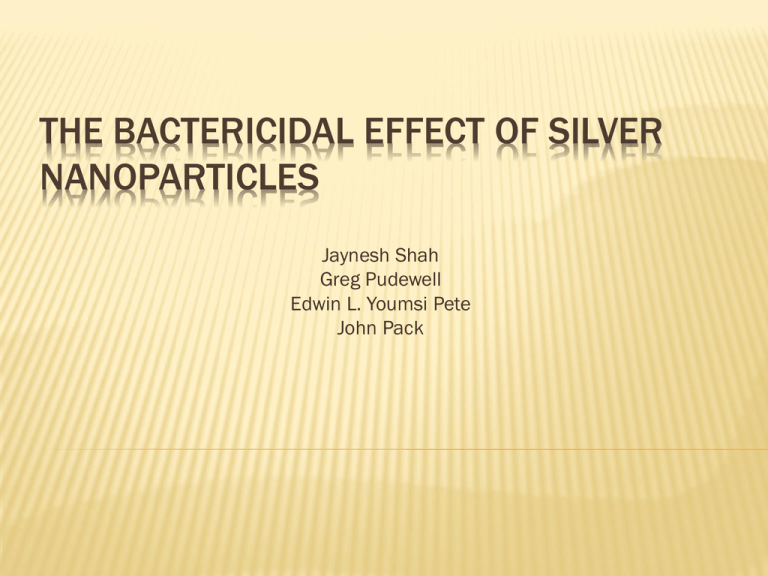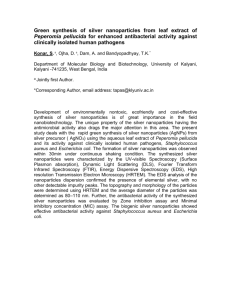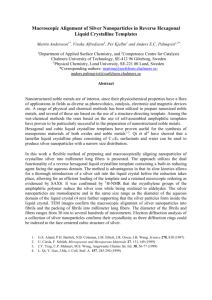U5: The Bactericidal Effect of Silver Nanoparticles
advertisement

THE BACTERICIDAL EFFECT OF SILVER NANOPARTICLES Jaynesh Shah Greg Pudewell Edwin L. Youmsi Pete John Pack OUTLINE Introduction Methods Results and Discussions Conclusions PROBLEM? Strains of bacteria resistant to current antibiotics Strong incentives to develop new bactericides Bactericidal nanomaterials could be extremely helpful and are being pursued in a timely manner http://wiki.sis.edu.hk/users/12leungrj2/ MEMBRANE STRUCTURES Bacteria have different membrane structures Gram-negative Based on organization of key component, peptidoglycan, in the membrane Thin peptidoglycan layer (~2-3 nm) between the cytoplasmic membrane and the outer membrane Gram-positive No outer membrane, but have a thick peptidoglycan layer (~30 nm) http://silverfalls.k12.or.us/staff/read_s hari/mysite/chapter_24_AB.htm SILVER BASED COMPOUNDS Silver is known to exhibit a strong toxicity to a wide rang of microorganisms. Extensive use in many bactericidal applications http://www.shutterstock.com/pic3609757/stock-photo-silversymbol.html Inorganic composites with a slow silver release rate used as preservatives Compounds composed of silica gel microspheres containing a silver thiosulfate complex are mixed into plastic for long lasting antibacterial protection Silver compounds used in the medical field to treat burns and a variety of infections. http://www.los-angelesinjury-lawyerblog.com/2008/03/california _burn_lawyer_acciden.html BACTERICIDAL EFFECTS AND MECHANISM Bactericidal effect of silver ions on micro-organisms is well known, but the mechanism is only partially understood. Proposed theory describes that ionic silver strongly interacts with thiol groups of vital enzymes and inactivates them. http://www.advancedagrotech.com /a/pr_nanopaints.htm PREVIOUS RESEARCH DNA loses its replication ability once the bacteria have been treated with silver ions Evidence of structural chances in the cell membrane as well as the formation of small electron-dense granules formed by silver and sulfur http://www.pbs.org/wgbh/nova/sciencenow/ 3214/01-coll-04.html CHANGES WITH NANOTECHNOLOGY Physical properties of metal particles at the nanoscale differ from those of the ion and the bulk material. Particles exhibit remarkable properties such as increased catalytic activity due to morphologies with highly active facets. http://www.anapro.com/english/product /nano-silver-paste.asp EXPERMENTAL PROCEDURE Silver is tested with four types of Gram-negative bacteria E. coli V. cholera P. aeruginosa S. typhus Apply several electron microscopy techniques to study the mechanism by which silver nanoparticles interact with these bacteria http://www.biologie.uni-hamburg.de/bonline/e03/03e.htm PREPARATION OF SILVER NANOPARTICLES The silver nanoparticles used in this work were synthesized by Nanotechnologies, Inc. The final product is a powder of silver nanoparticles inside a carbon matrix, which prevents coalescence during synthesis. The silver nanoparticle powder is suspended in water in order to perform the interaction of the silver nanoparticles with the bacteria; for homogenization of the suspension a Cole-Parmer 8891 ultrasonic cleaner (UC) is used. The particles in solution are characterized by placing a drop of the homogeneous suspension in a transmission electron microscope (TEM) copper grid with a lacy carbon film and then using a JEOL 2010-F TEM at an accelerating voltage of 200 kV. FIRST STEP: TESTING OF SILVER NANOPARTICLES As a first step, several concentrations of silver nanoparticles (0, 25, 50, 75 and 100 μg ml−1) were tested against each type of bacteria. Agar plates from a solution of agar, Luria–Bertani (LB) medium broth and the different concentrations of silver nanoparticles were prepared, followed by the plating of a 10 μl sample of a log phase culture with an optical density of 0.5 at 595 nm and 37 ◦C. INTERACTION OF BACTERIA WITH SILVER NANOPARTICLES The interaction with silver nanoparticles was analysed by growing each of the bacteria to a log phase at an optical density at 595 nm of approximately 0.5 at 37 ◦C in LB culture medium. Then, silver nanoparticles were added to the solution, making a homogeneous suspension of 100 μg ml−1 and leaving the bacteria to grow for 30 min. The cells are collected by centrifugation (3000 rpm, 5 min, 4 ◦C), washed and then resuspended with a PBS buffer solution. A 10 μl sample drop was deposited on TEM copper grids with a lacy carbon film and the grid was then exposed to glutaraldehyde vapours for 3 h in order to fix the bacterial sample. The bacteria were analysed in a JEOL 2010-F TEM equipped with an Oxford EDS unit at an accelerating voltage of 200 kV in scanning mode using the HAADF detector, in order to determine the distribution and location of the silver nanoparticles, as well as the morphology of the bacteria after the treatment with silver nanoparticles. ALTERNATIVE SAMPLE PREPARATION TECHNIQUE In order to have a more profound understanding of the bactericidal mechanism of the silver nanoparticles, a different sample preparation technique was prepared E. coli samples, previously exposed to silver nanoparticles, following the same procedure of interaction mentioned previously, were then fixed by exposure to a 2.5% glutaraldehyde solution in PBS for 30 min, followed by a dehydration of the cells using a series of 50, 60, 80, 90 and 100% ethanol/PBS solutions and exposing the sample for ten minutes to each solution in increasing order of ethanol concentration The cells were finally embedded into Spurr resin and left to polymerize in an oven at 60 ◦C for 24 h. The polymerized samples were sectioned in slices of thickness of ∼60 nm. We were then able to analyse the interior of the bacteria in the TEM in STEM mode. The same procedure but with 100 μg ml−1 of ionic silver, from a 1 mM solution of AgNO3, was performed to compare effects of silver in ionic and nanoparticle form. TEM ANALYSIS USING SAMPLE STAINING TEM analysis using sample staining was also carried out. The sample preparation followed the same procedure as the cross-sectioned sample slices but before the dehydration process the cells were tinted with a 2% OsO4/cacodylate buffer for 1 h. These samples were analysed in a JEOL 2000 at an accelerating voltage of 100 kV. ANALYSIS OF THE ELECTROCHEMICAL BEHAVIOUR OF SILVER NANOPARTICLES The electrochemical behaviour of silver nanoparticles in water solution was also analysed. Stripping voltammetry of silver nanoparticles, in dissolution in an electrolyte solution, was carried out using a 25 μm diameter platinum ultramicroelectrode. To detect silver (I) electrochemically at low concentrations, it is necessary to electro-deposit silver onto the electrode surface in a pre-concentration step by holding the potential of the electrode at −0.3 V versus Ag/AgCl for 60 s This procedure reduces Ag+ to Ag0, which plates onto the electrode surface. When the potential is swept positively from −0.3 to +0.35 V, the deposited silver is oxidized to Ag+ and stripped from the electrode, giving a characteristic stripping peak with a height proportional to the concentration of Ag+ in the solution. STRIPPING VOLTAMMETRY RESULTS TEM analysis shows silver particles agglomerated inside the carbon matrix a) illustrates the agglomeration b)-d) most common morphologies of the particles used are cuboctahedral, icosahedral, and decahedral RESULTS Each type of bacteria required different concentrations of silver Upper left, E. coli Upper right, S. typhus Bottom left, P. aeruginosa Bottom right, V. cholerae RESULTS Nanoparticles are found on the cell membrane as well as inside the bacteria Cells on the membrane and the interior are the same size Particles that interact with the membrane is faceted, most likely decahedral Mean size of interacting particle was 5 nm Suggests that bactericidal effect of particles is size dependent RESULTS a) b) c) d) e) Shows presence of silver nanoparticles in membrane of E. coli Close up of E. coli membrane Close up of E. coli interior E. coli treated with silver nitrate Shows silver ions immediately released at concentration of 1 micromolarity RESULTS Results lead to three hypotheses Nanoparticles smaller than 10 nm interact with bacteria Nanoparticles are spherical Amount of carbon in the sample can be ignored Weight percent of nanoparticles between 1 and 10 nm makes up only 0.093% of the sample This seems small but concentrations over 75 micrograms/ml eliminated all bacterial growth 0.093% corresponds to more than enough nanoparticles RESULTS a) b) c) d) Silver particles can be seen in S. typhus Intensity profile of localized region in a) Morphology distribution Size distribution RESULTS Silver nanoparticles affect alterations in the membrane of the bacteria Nanoparticles may react with DNA Also affect the cell in areas such as the respiratory chain and cell division, ultimately resulting in cell death Possible electrostatic interaction between charged particles and charged bacterial wall CONCLUSIONS Silver nanoparticles act in three ways against gramnegative bacteria. Attach to the surface of the cell membrane perturb its proper function Penetrate inside the bacteria and cause damage Release silver ions, which will have an additional contribution to its bactericidal effect http://farm1.static.flickr.com/137/355583438_3667e9ef f0.jpg CONCLUSIONS Metallic nanoparticles have antibacterial properties and exhibit increased chemical activity. This is due to their large surface to volume ratios and crystallographic surface structure. http://wwwche.engr.ccny.cuny.edu/ilona/public/asymm_silver.jpg CONCLUSIONS http://science-hub.com/wpcontent/uploads/2009/06/nanoparticles1.jpeg High angle annular dark field (HAADF) scanning transmission electron microscopy (STEM) has been proven to be a very useful in the study of bactericidal effects of silver particles FURTHER RESEARCH Application of HAADF-STEM should be extended to other related research Effect of electrostatic forces on interaction of the nanoparticles with bacteria should be further studied. Understand the formation of low density region formation is a mechanism of defense http://www.nanotechnologyinvesting.us/nanotechnolog y-robot-530.jpg








